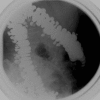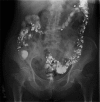Therapeutic high-density barium enema in a case of presumed diverticular hemorrhage
- PMID: 23136564
- PMCID: PMC3487145
- DOI: 10.1159/000322911
Therapeutic high-density barium enema in a case of presumed diverticular hemorrhage
Abstract
Many patients with lower gastrointestinal bleeding do not have an identifiable source of bleeding at colonoscopy. A significant percentage of these patients will have recurrent bleeding. In many patients, the presence of multiple diverticula leads to a diagnosis of presumed diverticular bleeding. Current treatment options include therapeutic endoscopy, angiography, or surgical resection, all of which depend on the identification of the diverticular source of bleeding. This report describes a case of recurrent bleeding in an elderly patient with diverticula but no identifiable source treated successfully with barium impaction therapy. This therapeutic modality does not depend on the identification of the bleeding diverticular lesion and was well tolerated by our 86-year-old patient.
Keywords: Anemia; Diverticula; Diverticular hemorrhage; Hematochezia; Lower gastrointestinal bleeding; Therapeutic barium enema.
Figures



Similar articles
-
Diagnosis and treatment of bleeding colonic diverticula.Hepatogastroenterology. 2001 May-Jun;48(39):702-5. Hepatogastroenterology. 2001. PMID: 11462907
-
Therapeutic barium enema for bleeding colonic diverticula: four case series and review of the literature.World J Gastroenterol. 2008 Nov 7;14(41):6413-7. doi: 10.3748/wjg.14.6413. World J Gastroenterol. 2008. PMID: 19009662 Free PMC article. Review.
-
Effectiveness of high-dose barium enema filling for colonic diverticular bleeding.Colorectal Dis. 2011 Aug;13(8):896-8. doi: 10.1111/j.1463-1318.2010.02350.x. Epub 2010 Jun 10. Colorectal Dis. 2011. PMID: 20553313 Clinical Trial.
-
High-dose barium impaction therapy is useful for the initial hemostasis and for preventing the recurrence of colonic diverticular bleeding unresponsive to endoscopic clipping.Case Rep Gastrointest Med. 2013;2013:365954. doi: 10.1155/2013/365954. Epub 2013 May 9. Case Rep Gastrointest Med. 2013. PMID: 23762666 Free PMC article.
-
[Endoscopy, angiography, surgery: diagnostic and therapeutic algorithms for diverticular bleeding].Chirurg. 2019 Aug;90(8):621-630. doi: 10.1007/s00104-019-0950-0. Chirurg. 2019. PMID: 30976892 Review. German.
Cited by
-
Management of Diverticular Bleeding: Evaluation, Stabilization, Intervention, and Recurrence of Bleeding and Indications for Resection after Control of Bleeding.Clin Colon Rectal Surg. 2018 Jul;31(4):243-250. doi: 10.1055/s-0037-1607963. Epub 2018 Jun 22. Clin Colon Rectal Surg. 2018. PMID: 29942215 Free PMC article. Review.
-
Effectiveness of therapeutic standard concentration barium enema for colonic diverticular bleeding: Preliminary results.Eur J Radiol Open. 2019 Apr 8;6:139-143. doi: 10.1016/j.ejro.2019.03.005. eCollection 2019. Eur J Radiol Open. 2019. PMID: 31016208 Free PMC article.
-
Initial management for acute lower gastrointestinal bleeding.World J Gastroenterol. 2019 Jan 7;25(1):69-84. doi: 10.3748/wjg.v25.i1.69. World J Gastroenterol. 2019. PMID: 30643359 Free PMC article. Review.
-
Lower GI bleeding: a review of current management, controversies and advances.Int J Colorectal Dis. 2016 Feb;31(2):175-88. doi: 10.1007/s00384-015-2400-x. Epub 2015 Oct 10. Int J Colorectal Dis. 2016. PMID: 26454431 Review.
References
-
- Gostout CJ, Wang KK, Ahlquist DA, et al. Acute gastrointestinal bleeding. Experience of a specialized management team. J Clin Gastroenterol. 1992;14:260–267. - PubMed
-
- Jensen DM, Machicado GA, Jutabha R, Kovacs TO. Urgent colonoscopy for the diagnosis and treatment of severe diverticular hemorrhage. N Engl J Med. 2000;342:78–82. - PubMed
-
- Gordon RL, Ahl KL, Kerlan RK, et al. Selective arterial embolization for the control of lower gastrointestinal bleeding. Am J Surg. 1997;174:24–28. - PubMed
Publication types
LinkOut - more resources
Full Text Sources

